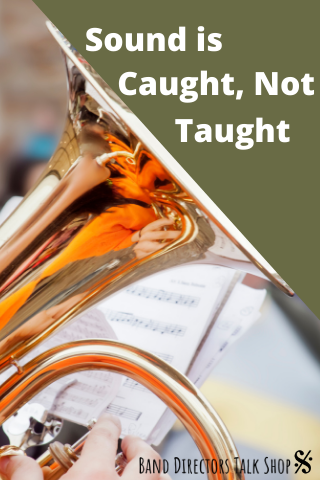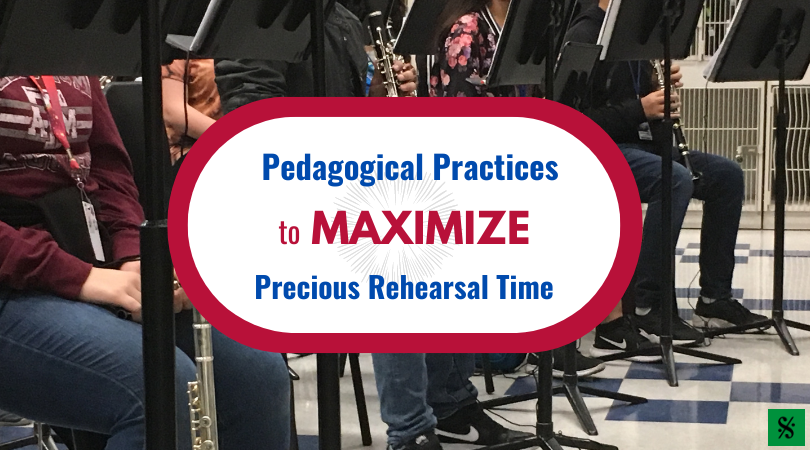Beyond the beginning band stage, I have never had much success teaching students how to develop a great sound by using mechanical cues. Explaining to them, for example, that they should form an embouchure in a specific way or make other precise movements generally seems to be, at best, a waste of time; at worst, a net negative. Doing so gets students thinking about the wrong things, e.g. mechanical/physical processes, or how their body works or needs to move. What they should be thinking about is, “What do I want to sound like right now?”
So how do you get brass players to play with a great sound? There are many things that we as instructors can do to help students achieve their best sound.

Emphasize Sound Quality
There is nothing more important to great brass playing than producing a vibrant, resonant, beautiful sound. Emphasize the importance of playing with a great sound. I frequently remind my students that sound is the most important aspect of brass playing because it is the first thing each audience member will notice and probably also the easiest to hear.
Breathing
We breathe all day, every day. So why do brass players have such a hard time breathing when they play? The answer to that is most of our breathing is done involuntarily. No one ever thinks about breathing while they watch TV or brush their teeth (you might now, though). Breathing to play a brass instrument – especially low brass – is vastly different from how we normally breathe.
Imagine breathing during a conversation. Are your breaths deep, relaxed, full? How are you breathing right now? It is probably shallow and minimal. In this situation, that is fine. Now imagine how Olympic swimmers breathe: a very rapid inhalation after bringing their head above the water, followed by a gradual exhalation as they glide through the water.

It takes up to 120 liters of air per minute to play tuba in an orchestra. That is 40 three-liter bottles full of air that orchestral tuba players cycle each minute while playing. As such, breathing for brass players should be more like that of Olympic swimmers. The inhalation must be rapid, full, deep, and relaxed. The exhalation needs to be relaxed, but also very controlled and much slower than the inhalation.
There are several important aspects of the inhaled breath that students must grasp. Each inhalation should be deep (full capacity), relaxed (only enough tension to hold the instrument to their face), and rapid (as quick as they can and still satisfy the first two conditions). The way to facilitate this style of breathing is with an “OH” syllable while inhaling and exhaling. I like to tell students to “Breathe like Darth Vader”.
Long Tones
Long tones are often neglected by brass players. This is understandable since they are not the most exciting commonly prescribed exercise. However, long tones are of crucial importance to the development (and maintenance) of a great low brass sound. They are most important when the person playing them is engaged and present while doing so. Unfortunately, the default mental state for most people when working on long tones is to go on autopilot. Mindless long tones are a waste of time. Mindful long tones, however, are the most effective exercise ever conceived for refining sound quality. With each extended note being played the student has the chance to further improve the sound they produce.
Low Register
When playing a brass instrument, it takes twice as much air to play at a given dynamic level for each octave lower. If a brass player is not breathing well as they play, it will be obvious in the low register. Therefore having students practice in the low register is one of my favorite ways to reinforce good breathing habits. It is also beneficial because it can be much more challenging to play in the low register with a great sound than it is in the middle register. If the student can make a good sound down low, they are much more likely to be able to do so in higher ranges.
Ear Training
To understand what a great sound is, students must first be able to hear the sound clearly. The value of a well-trained ear cannot be overstated when it comes to being a musician. I have students work on many ear training exercises regularly.
My favorites include:
- pitch-matching
- having students play a note in tune with me
- playing by ear
- having the student learn a melody without having the written notation
- record and review (having a student listen to a recording of themselves and critique what they hear)
Listen to Great Sounds
This is an easy idea in principle, but not in practice. You must show students why they need to listen to players with great sounds. A few of my favorites are Floyd Cooley, Gene Pokorny, and Demondrae Thurman. These are all fantastic low brass players each with solo recordings that are widely available. They can also be found online easily. Urge your students to listen to them regularly, not just when they need a reference recording to learn a new piece.
Imitate Great Sounds
Once students have a hold on what a great sound is, they can start to imitate it. I ask students a couple questions: “Who’s your favorite player? How would they play this? Now, imagine yourself playing it just like them.” You will be amazed by how well this works. Imitation is also a useful skill in situations like learning to play more musically. “How would (insert favorite player’s name) play this phrase?”
When working with students to catch their best sound, always remember that the process takes time and needs frequent refreshing and reminding. Sound is something I constantly strive to improve not only in my students, but also in my own playing. The best thing we can do as instructors is to help students catch their best sound by introducing them to the concepts above.
Jeremy Lewis is an Associate Professor of Tuba and Euphonium at West Texas A&M University and has been teaching at WT since 2008. He is also the principal tubist with the Amarillo Symphony, a position he has held since 2009. Dr. Lewis is active as a soloist and chamber musician and maintains www.JeremyLewisTuba.com. He lives in Amarillo, TX, with his wife and two daughters.
Related Reading:
Dive Bombs: Better Low Brass Pitch Through Better Sound
Utilizing Sound Concepts When Teaching Brass
Brass YouTube Finds for Your Students
If you would like to receive our weekly newsletter, sign up here.
Don’t forget to like us on Facebook too!
Learn. Share. Inspire.
BandDirectorsTalkShop.com






Leave a Reply
You must be logged in to post a comment.